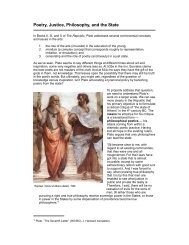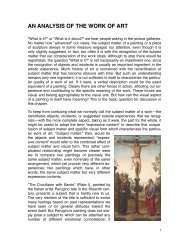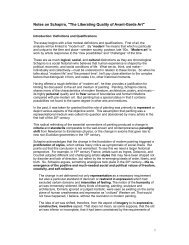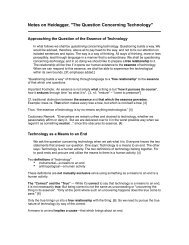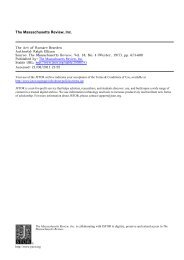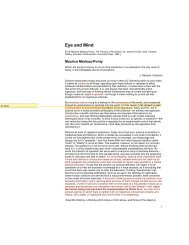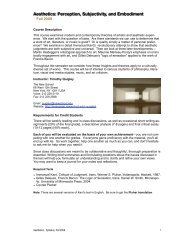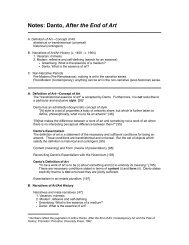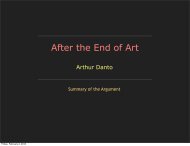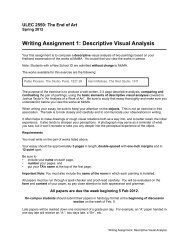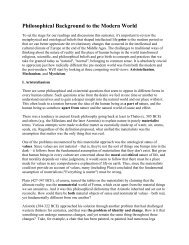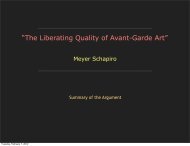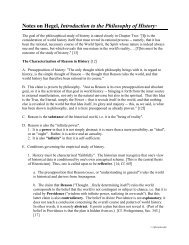AN ANALYSIS OF THE WORK OF ART - Timothy R. Quigley
AN ANALYSIS OF THE WORK OF ART - Timothy R. Quigley
AN ANALYSIS OF THE WORK OF ART - Timothy R. Quigley
Create successful ePaper yourself
Turn your PDF publications into a flip-book with our unique Google optimized e-Paper software.
<strong>AN</strong> <strong>AN</strong>ALYSIS <strong>OF</strong> <strong>THE</strong> <strong>WORK</strong> <strong>OF</strong> <strong>ART</strong>Taylor’s argument for the roleand importance of “visual forces”in a work of art.Definition of “subject matter”of a work of art.Definition of “expressive content”.Taylor’s experiment: Hold thesubject matter fixed and vary theexpressive content."What is it?" or "What is it about?" we hear people asking in the picture galleries.No matter how "advanced" our views, the subject matter of a painting or a pieceof sculpture always in some measure engages our attention, even though it isonly slightly suggested. In fact, too often it is with the recognition of the subjectmatter that our consideration of the work stops. Although to stop there would beregrettable, the question "What is it?" is not necessarily an impertinent one, sincethe recognition of objects and incidents is usually an important ingredient in theartistic experience. Much history of art is concerned with the reclarification ofsubject matter that has become obscure with time. But such an understandingremains only one ingredient; it is not sufficient in itself to characterize the particularquality of a work of art. If it were, a verbal description could be the exactequivalent of a painting. Clearly there are other forces in action, affecting our experienceand contributing to the specific meaning of the work. These forces arevisual and belong appropriately to the visual arts. But how can the visual aspectof a painting in itself have meaning? This is the basic question for discussion inthis chapter.To keep from confusing what we normally call the subject matter of a work—theidentifiable objects, incidents, or suggested outside experiences that we recognize—withthe more complete aspect, taking as it were, the part for the whole, itmight be useful to adopt the term "expressive content" to describe that uniquefusion of subject matter and specific visual form which characterizes the particularwork of art. "Subject matter," then, would bethe objects and incidents represented; "expressivecontent" would refer to the combined effect ofsubject matter and visual form. This rather complicatedrelationship might become clearer werewe to compare two paintings of precisely thesame subject matter, even nominally of the samearrangement, which yet provide very different experiences;two paintings which have, in otherwords, the same subject matter but very differentexpressive contents.Here Taylor assumes and describesthe overall effect producedin the painting and thensets out to demonstrate how thatexpressive content is establishedthrough the use of certain visualforms or components of the work."The Crucifixion with Saints" (Plate I), painted bythe Italian artist Perugino late in the fifteenth century,presents a subject that is hardly new to us.The very mention of the title is sufficient to evokemany feelings based on past representations wehave seen or on general attitudes toward theevent itself. But Perugino's painting does not simplypose a subject to which can be attached anynumber of different emotional connotations; it1
would seem to quell the possible anguish and effects of suffering which might beassociated with the scene and to establish a serenity and calm, a complete relaxationof the emotional and physical forces which might be expected to operatein connection with such a subject. Perugino has at once presented a subject anda statement about it. He has made us feel in a particular way about the Crucifixion,in a way we may not before have considered. Instead of being just the repetitionof a familiar subject, the painting becomes, then, the basis of a new experience.Since the particular character of this new experience seems not to be theinevitable product of the subject, it behooves us, if we wish to discuss the peculiarpower of the painting, to discover on what it depends: what produces the effectof calm, of limpid clarity, an atmosphere in which contemplation takes theplace of physical violence. For this we must look to the visual forms of the paintingitself.So instantaneously does a painting seem to produce its effect that it is difficult toseparate the steps by which the effect is achieved, and it must be admitted thatsuch a separation is an arbitrary one. Nonetheless, it may lead us past the simplelevel of subject-matter identification to the particular character we associatewith this painting, a character inseparable from our visual experience.Detailed analysis of the Peruginopainting begins here.analysis of colorSaturation is, roughly, theamount or purity of a particularcolor. You can also think of it asthe amount of white or grey, thepurest containing no white orgrey, i.e. nothing that would dilutethe color.To begin on quite a literal level, this painting shows us, in a landscape that seemsto extend at measured pace directly into depth, two figures standing on eitherside of the Cross upon which is fixed the figure of Christ. The vista seems calm,progressing through the repetition of gently curved horizontal lines suggesting aseries of planes which overlap and repeat each other. In contrast, the compact,vertical forms of the figures seem somewhat isolated. We look from the figure ofSt. John on the right, to Christ, to the Virgin, and back again, and yet have littlefeeling that these persons could make physical contact with one another. Eachpart of the painting, landscape as well as figures, seems to take its place in afixed harmony, and a sense of stately measure results.But before considering this relationship further, study for amoment the color environment of which these forms arepart. The number of hues employed in the work is smalland the eye quickly accepts the simplicity of their relationship.It would be difficult to say whether the paintingseems warm or cool in tone, tending toward red or towardblue. The hues of blue and yellow appear to be almostequal in quantity, although the yellow is far less vivid thanit appears in the solar spectrum: it is low in saturation, touse a term defined in chapter ii. As a kind of intermediatecolor there is a bit of green which, containing both yellowand blue, serves as a buffer between them. But of fargreater power in holding our attention than this intermediarygreen is the vivid red robe of the right figure, St. John.Because of the nature of the hue and its high saturation,2
Primary colors are used toachieve a sense of equilibrium.Definition of “primary colors”.An analysis of the relationshipsamong the colors of thepainting begins here.“Value” refers to the amount oflight or dark in a color.I’ve stripped out the red in thereproduction on the right so thatyou can see the effect on thecolor balance and, as a result,the change in the expressivecontent that Taylor is describing.it seems equal in importance to the blue and yellow. Red, blue, and yellow, subtlymodulated in value but distinct and uncomplicated as hues, achieve in the paintinga kind of equilibrium. Both the distinctness of the hues and the effect of balancemay be understood by studying the charton page 70, which illustrates the fact thatthese colors, called primaries, contain no partof each other and as a group represent a balanceof the entire spectrum. That colors provokea direct emotional response we constantlybear witness to in everyday speech: wesee red, feel blue, and speak of a dark character.Had Perugino caused his red to dominateover the other hues so that it might seem tocharacterize the entire atmosphere—and avery warm atmosphere it would seem—our reactionto the painting would be very different. Instead there is an equilibrium ofhues just as there is a marked clarity in the distinction of one hue from another,and this equilibrium and clarity are part of our experience of the painting.Color, however, does more than simply characterize generally the emotional climateof the work. The hues occur in different relationships, sometimes red nextto yellow, sometimes red next to blue, and in the background there is a kind ofsequence rangingfrom yellow throughgreen into blue.These relationshipsa r e m a d e m o r ecomplex and varied,by the modificationof the hues in lightand dark, that is, invalue, and in saturation.Note, for example,the difference inblue between thesky, the tunic of St.John, and the robeof the Virgin. Coverfor a moment the redrobe of St. John witha piece of dark paper.Not only is thekey of the paintingbasically changed, but the figures no longer bear the same relation to each other.Instead of our eye's going first to the figure of St. John and then rising to the figureof Christ, we seize at once upon the figure of Christ which pushes forward,3
losing all contact with the lower part of the painting. This is not just a compositionalvariation but a dramatic change in the way we feel about the painting, in itsexpressive content. Further, note the distribution of blue and yellow. The blue ofthe sky is carried through the lower portion of the painting in the tunic of St. John,in which it is slightly changed, and in the robe of the Virgin, in which it is very lowin value and saturation. The yellow follows a more complex scheme. In the landscapeit is broken up into contrasting areas of light and dark that become lessmarked as the yellow fuses with the green to merge imperceptibly into the blue.But this complexity prepares us for the dramatic appearance above of Christ, inwhose body the yellow is freed to contrast simply and eloquently with the rivalblue.Preliminary conclusions arestated here.Analysis of line.Analysis of shape.From this kind of study we might draw some general conclusions. Our eye tendsto relate similar colors. Further, strong contrasts, whether of hue or of value, tendto attract our attention immediately, while gradual changes seem to lead us progressivelyfrom one step to the next. In this way our eye seems to move aboutthe painting from color to color, from points of greater to points of lesser contrastor through marked sequences, following a pattern which may vary with regard topoint of origin or concentration but not in expressive character.The nature of this pattern, sensed as we shift our attention from one part of thepainting to another, should be considered with care since, as in our gestures,much feeling can be conveyed in the experience of movement. As we noted, ourattention unites chiefly three points: the figures of the Virgin and St. John and thefigure of Christ. Were we to diagram this relationship itmight look like this: How tremendously extended thevertical movement seems. While the Cross divides thepainting into halves that are about equal in their attractionof color and contrast, affording the measured effectof symmetry, the vertical movement is so insistent thatwe cannot linger for any time on the horizontals of thelandscape which cut across the painting and attempt tolure us plane by plane into depth. Yet these horizontals,especially the starkly defined bar of the Cross with thehelp of the contrasting inscription above the head ofChrist, hold the vertical movement in check so that againwe sense equilibrium rather than a dynamic continuity offorce. The importance to this aspect of the organizationthe tiny inscription assumes by virtue of its valuecontrastand shape can be tested by covering it with a piece of dark paper. Thatso much should depend on so small an element is indicative of the delicacy ofbalance which distinguishes this painting, a delicacy encouraging us to comparepart with part and enjoy the justness of proportion. To a large extent, the relationshipswe have just observed are dependent on our perception of line, that is, thecontinuity of direction. Each figure seems to contain within itself a vertical linecontrasting with the horizontal line of landscape and other elements. Moreover,4
diagonal lines, implied by our shift in attention rather than being explicit in anyform, seem to go from the head of St. John to that of Christ, then down to Mary tobecome a part of a great elongated diamond shape completed by the suggestionof the two wedges at the foot of the Cross. It would be meaningless to point outsuch a shape except that in this case its symmetry gives new reason for thesense of stability and balance we derive from the painting.Our consciousness of a particular proportion, a sense of measure, which determinesour movement through the large structural lines of the painting is dependenton a great many factors. For example, consider the shape of the painting asa whole. It is considerably taller than it is broad, though not so tall as to minimizecompletely the measurement of width. This is important, since the framing shapequalifies the effect of every form created within it. Suppose the construction linesThe effect of scale.Analysis of rhythm & movementbegins here.remained the same but were contained within a different format: Each of theseschemes would be quite possible, but the effect of the pictures, their expressivecontent, would be very different. Scale also plays its part. We quickly take as amodule, as a kind of measure, some identifiable object or simply a stronglymarked form, and judge the rest of the space in comparison with it. Not only arewe brought close to or left far from. the subject, but we can feel ourselves lost ina vast expanse or painfully crowded in a confining space.But to characterize the painting simplythrough its precise adjustment of verticaland horizontal structural lines within thedetermined format would be to ignoremuch of its particular effect. Although thefigure of St. John may count roughly as avertical movement with regard to thewhole, it embodies in its contours and impliedinterior lines rhythmical movementsthat not only give character to the figurebut bring it into a harmony with other forms in the picture. In the very simplestterms these might be seen as flattened, drawn-out curves which in themselvesseem to produce the effect of slow, co-ordinated movement. Note how similarlines, sometimes depending on contrasting contours, sometimes seeming to bewithin the forms as a core, characterize also the figure of Christ. Since our eye is5
quick to relate like things, we sense the figures as existing together in a rhythmicalharmony even though the figures do not lose their compactness as entitiesnor seem in themselves to move. Nor are these rhythms confined to the figures.Examine the trees—for example the entwining branches of the one delicately silhouettedon the right which move in quiet undulation—the long smooth curve ofthe road and bridge, the repeated arcs of the hills, all of which have a similarity ofcharacter, and you will see how far-reaching is the harmony that pervades thisparticular pictorial world.We have made only a rudimentary beginning in analyzing in pictorial terms ourexperience of this picture, and of course we should not stop without studying therelationship of this panel tothe two side panels thatcomplement it (see Fig. I below).This painting is, in fact,the central portion of a threepanelaltar piece, a triptych.The artist has had the problemof designing three compositionswhich are selfcontainedyet which join witheach other to form a singlewhole. The complete work isreproduced in Figure I. Notehow the side panels modifyand intensify various aspectswe have mentioned of thecentral painting. It is well toremember that a composition can be affected by forms outside itself, that twopaintings viewed together, for example, may take on a different aspect than whenviewed separately.6
But before we complete this study it might be useful to test our assumptions andour procedure thus far by looking at another painting of exactly the same subjectas our central panel.Analysis of Crivelli’s version ofthe crucifixion.An analysis of “color key” isdeveloped here.Combination of hues.The effect of the lower saturationof the colors.Plate II reproduces another "Crucifixion,"painted by the Italian artist CarloCrivelli, also late in the fifteenth century.The subject matter is identicalwith Perugino's painting: Christ isshown on the Cross between St. Johnand the Virgin; the rocky landscape,the towered building, and the sea inthe background are all familiar to us.Only the symbolic skull at the foot ofthe Cross has been added. But howdifferent is our response to the painting.Here is no rest, no calm or contemplation.Instead we take upon ourselvesthe anguish and physical hurtwhich seem to motivate the actions ofthe figures. And nowhere is there escape,no point on which our attentioncan fix itself to bring order to our excitedemotions. Yet the raw structure ofthe painting is the same as in the Perugino:two figures and the crucifiedChrist arranged traditionally in symmetrical fashion. On what, then, does thistremendous difference depend?We have used the term color environment or color key, and much of the effect ofclarity and balance in the Perugino depended on it. What is the color key of this?It is difficult even to name the colors used. For one thing, hues seem to combinewith one another in many areas, as in the background that seems to modulatefrom yellow to green and yellow to red, or in Mary's cape where the blue emergesin places with green and elsewhere itself moves toward red. As a result we areless conscious of defined color shapes than in the other painting. Furthermore,the hues are hard to describe; they seem to be "in-between" hues: the cloak ofSt. John is not quite violet yet not quite red. Characteristic of its intermediate nature,each hue is mixed with at least one other hue in the painting. Again in thecloak of St. John, even the red-violet is reduced in saturation with yellow to bringit into accord with the green and yellow of his other garments; only the white, unrivaledby vivid, saturated hues, makes a sharp contrast. While no hue dominatesthis painting any more than it did the work of Perugino, there is not the effect of acolor equilibrium existing between well-defined entities. Rather there is the impressionof slightly distinguishable color notes rising above a general tone. Both7
the nature of the hues themselves and the fact that almost all are used in lowsaturation contribute to this effect of a somber and minor harmony.Low contrast of value.Here Taylor introduces theconcept of the “picture plane”.The creation of rhythm andmovement in the forms.Analysis of line & shape.There is no one strong color note here to start the action as in the Perugino, norone sharp value-contrast. In fact, value-contrasts of almost equal attraction aredispersed throughout so that our eye seems to move quickly and constantly overthe entire painting. Unlike the other work, where details are massed and thereare large restful, unbroken areas, the whole surface is broken up by the scatteredknotty clouds (note how they are organized in the Perugino), the sharply contrastingplants, and the harshly defined stones—an agitated surface which entersinto the excitement of the moment. Yetwithin this general environment there is apositive path of movement that can beroughly suggested in a pattern of lines.There are many differences between thispattern and the one we experience in theother painting of like subject. For one thing,a single line of motion may move throughboth figure and landscape, uniting the twoin a continuously moving design. The rocksthemselves twist and bend in anguish withSt. John. The landscape does not proceedplane by plane into depth but seems upendedby the road, which is less inclined toretreat into the distance than to enter intothe swirling pattern of the picture plane, thatis, the plane represented by the panel itself.But the action that has created this pattern is more than continuous; it is rapidand violent. What produces this effect in a painting in which the figures themselvesseem hardly to move? One clue comes from a study of the lines andshapes that build up the very forms of the objects. Take again as example thefigure of St. John. The vertical structure-line of the figure has little meaning withregard to the effect of the whole,because the diagonal lines of hiscloak are so strong that they destroyall possible sense of a verticalcompact mass. And considerthe nature of the lines themselves.Every curve is flattenedand broken so that the line seemsto struggle to reach its destination.Furthermore, if we isolatethe line of the cloak, we see thatfar from suggesting the balanced arc of a circle, it seems rather like the lash of awhip. And this eccentric line is repeated throughout, in the robe of the Virgin, in8
the rocks, and even in the body of Christ. How contrasting with this is ourscheme of the St. John of Perugino. The lines of the Perugino seem to wrapthemselves together into a smooth-planed volume, while those of the Crivelli disperseinto the air, denying any sense of discrete volumetric form.The effect of value again.Taylor mentions the sense of“touch” but doesn’t say muchabout it. This is worth closerconsideration.Relations of form and scale.Greater emphasis on the pictureplane in Crivelli.Taylor compares the relativeproportion of forms and shapesin the works.There is another source of this effect—the particular use of light and dark. Wenoted that the distribution of color and contrasts of light and dark throughout thepainting was of a very different character from that of Perugino's work. Now notehow the light and shade on the figures relate to the character of this general lightand dark. In the cloak of St. John by Perugino each fold has its light side and itsdark, and the transition between the extremes of value is clearly defined and orderly.As a result we sense each fold as a continuous surface that we could followwith our hand as if touching a piece of smooth marble sculpture. In the Crivelli,however, each shadow is complicated with a further variety of light andshade, and the larger patterns are broken into smaller and yet smaller designs.The surface is far too complex to invite the stroke of our hand but, defying exactdefinition, seems to be in continuous action.Carried away by the furious movements and knotty rhythms which, together withthe strange minor color harmony, seem to characterize this painting, we haveoverlooked an important factor that is primary in any work of art: the proportionalrelationship of parts. In the first place, whatis the nature of the format? Compared to thePerugino, this painting in its arched frameseems broad to the point of squatness, aneffect intensified by the fact that the groundplane, the plane upon which the figuresseem to stand, is elevated through the suggestionof the cIiff-like break in the foreground.A similar proportion of width toheight pervades the Cross itself, which doesnot loom above us as does the slender, graceful Cross of Perugino, but remainstransfixed, massive and, solid, in the center of the painting. Even the plaqueabove the head of Christ conforms to this different proportional scheme. Nowheredo we have the contrast between length and width which contributes muchto the grace and delicacy of the Perugino; the length measurements seem lesslong, the widths less narrow. In consequence we are more conscious of the surfacethan we are of the direction implied by the shape. And we have seen howimportant that surface is in creating the effect of the Crivelli.A similar proportional feeling dominates both the relationship between figure andfigure and between the parts of the figures themselves. Consider, for example,the area St. John inhabits marked off clearly as a rectangle by the arms of theCross. In the Perugino, the shape is almost three and one-half times as high as itis broad, and the slim vertical figure of St. John occupies only the lower half. Wesee, then, the solid form against a vast expanse of void which in itself contributes9
to our feeling. But in the Crivelli the shape is only a little more than twice as highas it is broad, and the figure of St. John, much larger in scale and irregular inThe expressive role of proportion.The value of “productive ambiguity”and lack of closure inanalysis.A summary of the elementsused in visual analysis.contour, is placed close to the center. Here we do not sense the relationship betweenvoid and solid, nor do we experience the attenuated vertical movement ofthe Perugino. And look at the figures themselves. Even the bodily proportionscontribute. The head of Perugino's St. John relates to his height in the ratio of I :8 1/2, again a marked contrast in proportion between small and large. In Crivelli'sSt. John the relationship is 1:7, something less than average human proportion.This would suggest that in a work of art the proportions of nature are subservientto the expressive relationships on which the artistic content depends. Proportion,like line and color, is determined in a work not by an external standard but by theexpressive part it plays.In the foregoing paragraphs we have discussed many features that seem inseparablefrom our experience of these two very different paintings; yet, although wehave been able to distinguish the two experiences, we have not come very closeto defining the qualities which make the paintings unique and compelling worksof art. Even if we were to continue to analyze in this or in some other way formany more pages, some quality would still elude us. Some of us might be discouragedat this lack of finality; some might feel that, if a sure conclusion cannotbe reached, the analysis is not worth pursuing. We should remind ourselves thatthe very capacity of an effective work to elude definition gives it power to live inour experience. And the analysis serves to broaden our experience by refiningour perception of the individual work, leading us toward the definition of qualitythat can be completed only within the depths of our personal understanding.In describing the difference in effect, in expressive pictorial content, of these twopaintings, we have used a number of terms to describe the material elementswhich seemed inseparable from our experience: color, both as establishing ageneral key and as setting up a relationship of parts; line, both as creating asense of structure and as embodying movement and character; light and dark,which created expressive forms and patterns at the same time it suggested thecharacter of volumes through light and shade; the sense of volume itself andwhat might be called mass as contrasted with space; and the concept of plane,which was necessary in discussing the organization of space, both in depth andin a two-dimensional pattern. Towering over all these individual elements was the10
way they were put together, the composition, how part related to part and to thewhole: composition not as an arbitrary scheme of organization but as a dominantcontributor to the expressive content of the painting. It should be pointed out thathad we chosen other paintings, these and other elements would, of course, beused quite differently, and we might have reactedquite differently to them. In this respect, eachpainting must be regarded as a new experience,and the analysis of its particular formal aspectsimply as a means of characterizing its full expressivecontent.Are these terms and procedures applicable alsoto experiences of other visual arts? Reproducedin Figure 2 (to the left) is a photograph of a workcreated by the French sculptor Auguste Rodin inthe 1860's. Try to look beyond the artificial photographicframe and see it as an actually existingobject. The figure seems to struggle up intospace, reaching out into the surrounding world. Itis a melancholy struggle, a struggle of longing,which we sense as our own. As in the paintings,this movement can be described in terms of lineswhich we apprehend as underlying the forms,lines which seem to cross each other in space,twisting about in such a way as to make us particularlyaware of their actualthree-dimensional existence. But this movement is not onegreat uninterrupted sweep; it does not free us to expand airilyinto space. Nor does it seem the movement of smoothly interactingmuscles as in a gymnastic exercise. In fact, thesense of struggle seems to arise in part from the effort of theimplied interior movement to free itself from the complexmass of material. This complexity, which keeps our attentionsomehow tied within the figure, we can describe with the helpof some of the terms we have used before.Note what part light and dark play. The polished surface isconstantly interrupted by sharp ridges which catch the light,contrasting markedly with the shadowed concavities. Theselights and darks become in themselves lines and shapes of broken, agitatedcharacter with much the same rhythm as the varied and undulating lines of contour.Because of this activity of contour and surface we have little sense of compact,defined volumes. Instead we move in and out through the forms, for allthese ridges and contours, although they do not necessarily relate to specificanatomical features, seem to originate well within the mass.11
Plane in relation to line.Taylor introduces the importantconcept of “negative space”.Contrast these effects with those producedby the sculpture by Max Bill (Fig. 3 to theleft). To be sure, we do not have a humanfigure in motion, but can the feeling ofmovement be resisted any more than oureye can fail to pursue the flowing lines of astreamlined car? There is no sense ofstruggle in this movement. Our attention isdrawn swiftly through space, projectedboldly into void, only to be brought back torecognize a pattern of equilibrium, delicatelybut surely established. And nothing conflictswith this action. Instead, every elementspeeds it on its way. The sequential gradationsof light and dark on the smoothly polishedsurface create a sense of continuity ofplane consistent with the fluid rhythms ofthe contours. The function of plane, which ina sense is the extension in breadth of the element we have called line, is important.Because of its continuity we see the various movements as modulations ofa single surface: expansion and variety within a readily perceived unity. Theplane contributes, moreover, along with the design of the path of movement itself,to another quality of the work quite different from the Rodin. Note the spaces betweenthe planes, between the solid forms. They form shapes sympathetic incharacter to the rhythms we have spoken of. But more than shapes they suggestvolumes bounded by the planes and as expressive as the planes themselves. Yetit is characteristic of these volumes that, as we move around the work, they defyexact definition although they hold our attention within the balanced form. Ourattention does not remain entangled with the solid members as in the Rodin butmoves instead between related solids and voids. The consciousness of space,so differently displayed in these two works, might in some respects be consideredrelated to such compositional means as we have already studied in thepaintings. Although a work of sculpture is not usually contained within a frame,we are often made aware of an encompassing volume in which it seems to existand which gives particular meaning to both solids and voids. Sometimes this volumeseems defined and enclosed like a rigid block; in other works, as suggestedby the Rodin, it is indefinite and expanding yet nonetheless present.Rodin called his sculpture "The Prodigal Son." When we know the title our feelingsabout the work are rather confirmed than changed. It was not necessary,moreover, to know it to experience the emotional content, any more than it wasnecessary to examine the expression on the man's face. Max Bill called his worksimply "Tripartite Unity" without attempting to define the ramifications which thatunity and particular sense of equilibrium might have in our experience.12
The effects of color in sculpture.A word should be said about color, which plays its part in sculpture as well as inpainting. The sculpture of Rodin is in bronze of a warm dark tone; that of Bill hasthe cold silvery glint of chrome-nickel steel. These colors are not a matter ofchance but, like the materials themselves, were considered as expressive elementsin the creation of the work. Try to imagine the hues of the two sculpturesreversed. Our entire reaction would change: the Bill would probably seem heavyand plodding, while the Rodin would glitter superficially and the important depthand warmth of the surface shadows would be lost.Consider now views of two country houses (Figs. 4 and 5): the Villa Capra byAndrea Palladio [on the left] and the John Pew House by Frank Lloyd Wright [onthe right]. They were built in different climates some four hundred years apart andgive evidence of different social attitudes, different approaches to construction,and many other causal factors. But our immediate interest is to discover how wecan describe the great difference in our experience of the two buildings as theyexist immediately before us.Proportion of the planes.ValueIt is tempting to say that one is very formal while the other is casual and informal,but on what does such a distinction depend? Each, after all, was designed withdeliberation and forethought. The fact that both buildings are composed chiefly interms of planes arranged in parallel or at right angles to each other seems almosttoo obvious to mention; yet note the proportions of these planes. Most of those inthe house by Wright are very long and narrow and create a strong horizontal directionof movement. In those of Palladio'svilla the two dimensions are morenearly equal; our attention is somewhatstabilized between the horizontal and thevertical; we are more conscious of thedefined surface than of the direction theplane implies. And notice that in bothbuildings these proportional tendenciesare seen also in smaller parts like windows and doors. It is impossible also tooverlook the part played by light and dark in making some of these shapes moreimportant, more attractive, than others. This leads us to the fact that these dis-13
tinctions in proportion do not take us very far unless we consider the experienceof moving from part to part or from part to the whole: in other words, the characterof the composition.To clarify the differences of these organizations of planes as they appear in ourviews of the buildings, we might make simple diagrams. It is at once suggestedthat the formal dignity of Palladio's villa is dependent not only on the selfcontainedshapes but on their participation in a scheme of strict symmetry inwhich every part bears a fixed and readily perceptible relationship to every otherpart. A vertical axis is suggested in the very center of the facade to which all partsseem to make reference, repeating on either side exactly the same shapes andforms. Not only this, but the planes seem to be only the foreparts of simple cubicvolumes which unite around a clearly defined axis in the center of the building.An examination of the scheme underlying the plan bears out this consistency oforder.The organization of the Wright house is, however, much more difficult to define.The horizontal movement is continued throughout by the overlapping planes; yetsomehow these expanding parts are held together in a unified whole. There is nosimple geometric shape to bound the assembled forms—in fact it is difficult toconceive of the profile of the house by itself—but somewhere within the life ofthese moving forms we recognize a center that seems to unify them. This ismade the more complicated by the fact that these planes seem to relate also tovolumes which in turn bound other volumes, as for example the deep space betweenthe overhanging eaves and the balcony. Consequently our "center" seemsto lie within the complex of these interlocking volumes. But much as in the Billsculpture, this center of order can be experienced through the interplay of formsyet cannot be specifically defined. Our eye continues to move and search, seekingto experience to the utmost the elusive order existing within constant change.In Palladio the pleasure derives not from a sense of expansion and change but inthe justness of the harmonies and the completeness of the order in which we areinvited to participate.Compare the plans of the two buildings with the facades and you will see thatthere is an internal relationship that would strongly affect our experience whilewalking around or through the spaces of the buildings. But the special nature ofsuch experience will be discussed later. Here we must catch up two important14
Texture and color.elements we have neglected: texture and color. They are most assertive in thehouse by Wright. Not only does the color of the rough stones make a pleasingcontrast with the unpainted wood and unite happily with the rustic landscape, but,confined largely to areas which are vertical and supporting, the contrastingstones make more prominent the smoothhorizontal planes that, moving freely intospace, contribute most to the character ofthe building. The nature of this rich varietywhich demands our attention contributesmuch to the effect of informal intimacy wefirst noted in the building. Equally importantto the effect of clarity and measure characteristicof the Palladian villa are the uniformcoloring, broken only by the confined areasof light-and-dark pattern, and the smoothsurfaces of the well-defined planes. The nicetyof the regular and ordered compositiondepends on this polished smoothness.Our terms and our method have proveduseful in describing the experience of a varietyof works ranging widely in time, in medium,and in character. In discussing thearchitecture both planes and texturesseemed more significant than in the paintings;but had we chosen other examples,the relative importance of these elements might have been quite changed. Therough and smooth textures of paint are often of primary importance as, for example,in many paintings of Rembrandt; whereas linear continuity sometimes dominatesour attention in looking at a building. But in all these works meaning becameapparent only when these varied elements were brought together and consideredin terms of the total experience. The various sketches throughout thetext, while they may suggest the characteristics of parts, could never stand forthe work itself, which, once we enter into it, seems in its complexity constantly tooffer something new, some new relationship, some refinement of experience weoverlooked on our first view.Joshua C. TaylorFrom: Learning to Look: A Handbook for the Visual Arts, Joshua C. Taylor, Chicago and London:University of Chicago Press, 1981.15



